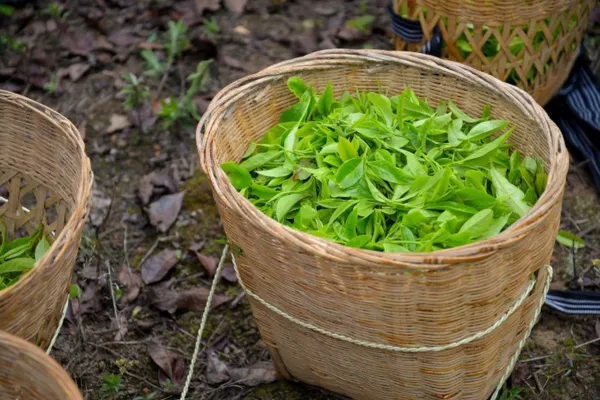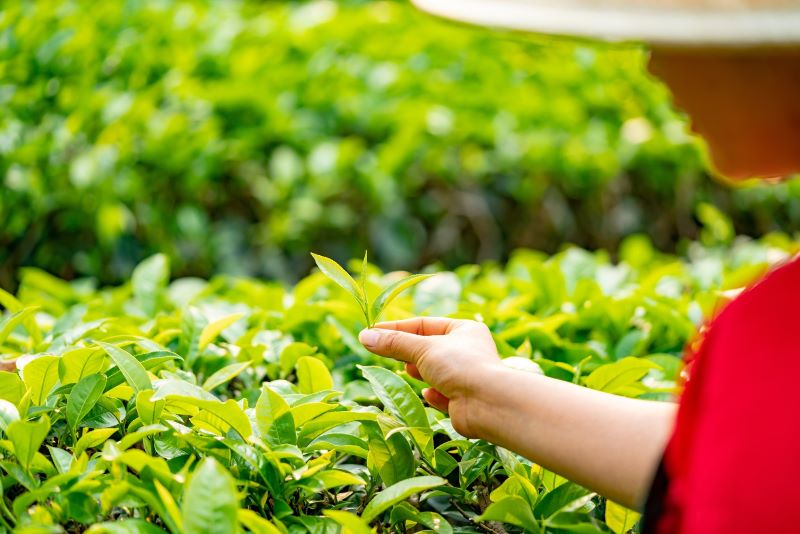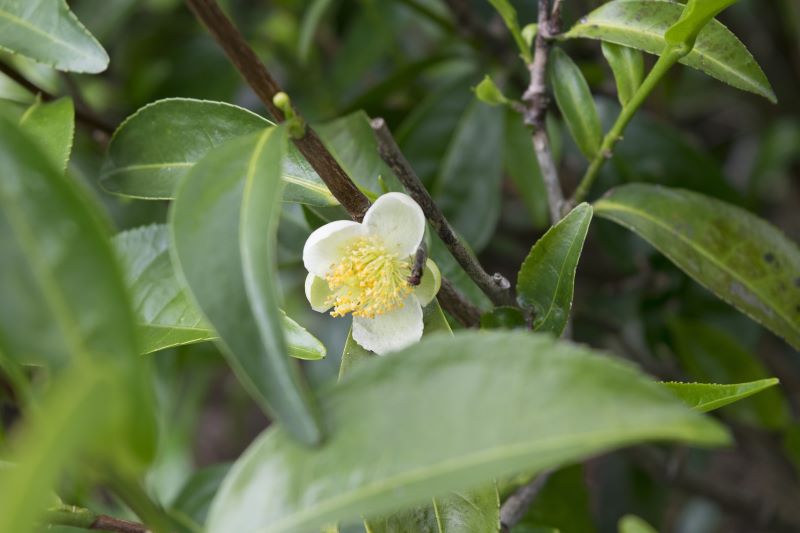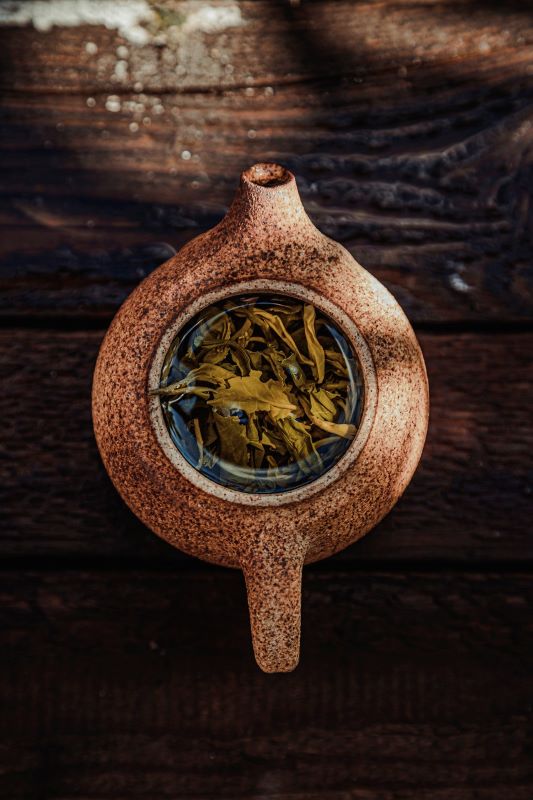
Your Backyard Fruit Bowl – Tea
Harvested leaf tea: Image by Patricio Hurtado via pixabay.com
The first sip is joy, the second is gladness, the third is serenity, the fourth is madness, the fifth is ecstasy.
- American novelist and poet Jack Kerouac, on tea.
Suitable climates and growing conditions
Pests, diseases and what to do about them
The next subject of our grow-it-yourself fascination is a pantry staple – tea, balm for the soul. It may not have quite a fashionable air about it as coffee does, but for many of us it is a daily essential and it’s the second-most consumed beverage worldwide, after water. The Food and Agriculture Organisation for the United Nations (FAO) estimates 6.4 million tonnes of tea was consumed worldwide in 2021.
Whether you prefer a mug of good old Kiwi gumboot (or builders’ tea, for those hailing from the UK), a delicate Earl Grey or a fancy matcha latte, the good news is that the base product all comes from the same plant and it’s one that is easily grown here in the Antipodes.
Along with many of our much-loved, little-bit-of luxury commodity crops such as cocoa and coffee, tea prices have also been skyrocketing. The cause for this increase is our changing climate and a complex suite of international tensions, factors which are largely out of the control of the roughly 13 million people worldwide involved in the tea-growing industry. Roughly 70% of these people are smallholder farmers, many for whom tea is a subsistence crop.
Piracy in the Red Sea necessitating longer sea journeys around the Cape of Good Hope, the rising cost of petroleum-based fertilisers and an increasing number of weather events such as heatwaves bringing drought conditions to tea-growing areas are all driving up the price of a cup.
The tea plant belongs to the same genus, Camellia, as the popular winter and spring-flowering ornamentals of the same name, and is similarly easy to grow, with glossy green foliage and delicate, fragrant white flowers.
Long-known to be highly sceptical of garden plants without an obvious culinary or medicinal use, I have recently permitted a lone tea plant onto the grounds here because of its potentially productive status and am keen to see how it fares. I was, however, slightly alarmed to read that tea is also related to azaleas, another just-for-looks garden stalwart. I’m currently locked in battle with my mother about removing a ratty-looking one of these from the premises – maybe I can convince her that the tea plant should take its place.
If you’re coffee-averse like me and depend on a few hearty brew-ups to get you through the day, just like an occasional cup, or happen to be a budding tasseographer (reader of tea leaves), all the more reason to pop a plant in your garden.
Tea: a short family history
Tea, Camellia sinensis, belongs to the Theaceae, a family of trees and shrubs that contains the widely-known ornamental genus Camellia, of which tea itself is the most well-known and economically important member. The Latin species epithet ‘sinensis’ translates as ‘from China’, hinting at the plant’s area of geographic origin, which is East Asia, namely northern Burma and southwestern China.
A plant of higher altitudes, each distinctive type of tea cultivated commercially relies on specific combinations of climatic conditions, soil type, local cultivation methods and postharvest processing to produce our favourite brews. Tea grown at higher elevations grows more slowly, but is said to have much more flavour than faster-growing, low altitude crops.
There are four recognised varieties of C. sinensis, two of which are in common commercial cultivation with the other two occasionally utilised on a local scale in their regions of origin.
The two commercial varieties and their subvariants are:
C. sinensis var. sinensis – smaller, bushier plants with small leaves. Native to eastern and southeastern China and the principal variety used to produce most Japanese-style green teas.
C. sinensis var. assamica - larger leaved, with a more tree-like growth habit. There are three main variants: Chinese Western Yunnan Assam, Indian Assam and Chinese Southern Yunnan Assam.
The assamica varieties are native to China and the Indian state of Assam, and the plants are larger in size, being more tree-like and have larger leaves in general than sinensis varieties.
Chinese small-leaved tea was introduced to India in the early 1800s and has resulted in a number of hybrids with native Indian assam types and other native wild-type teas, the well-known Darjeeling among them.
What tea growing and consuming history lurks in New Zealand’s past? Up until so-called specialty coffee arrived on the scene in New Zealand in the 1980s, tea was our national beverage of choice from daybreak to sunset and what we drank was always imported in origin. It was proffered by those involved in the temperance movement as a drink with universal appeal and acceptance at all levels of society, due to its ability to ‘refresh oneself in the absence of intoxication’.
As such, it gained great favour as an acceptable beverage of choice for women and spawned a great culture of tea gardens – places where ladies could begin to meet outside their homes, leaving their drawing rooms to congregate in socially-acceptable, public settings. This then led to the advent of the Kiwi stalwart ‘tearooms’, which soon graced every town and the remnants of which remain in provincial centres to this day. Little wonder then that at one point, New Zealanders consumed the most tea per capita worldwide.
Tea was first considered as a potential crop for New Zealand in the 1920s, given consideration when the increasing number of motor vehicles on the road decimated the market for locally-produced horse feed as an arable crop.
Both tobacco and tea were evaluated at this time, and the former took precedence as a quick cash crop. Tobacco was predominantly grown in the horticulturally-significant Motueka area up until reforms hit the 1970s, spurred by increasing health-related concerns around tobacco consumption, which led to the abolition of legislation supporting that industry.
Tea then found itself back in favour, although labour requirements and economies of scale made us an unlikely competitor on the world production scene for bog standard black tea. A fledgling green tea production system resulted instead, with the aim of exporting product to Japan in that country’s off-season. 95 hectares were planted in a single cultivar between 1981 and 1991, with the first harvest in spring 1991. Alas, the endeavour eventually failed, with crops devastated by frosts in 1994-1995 and not particularly helped by the single cultivar selected producing yellowish foliage (rather than the desired shade of green) under our high-UV light conditions. The initiative petered out in the latter part of the decade, perhaps a lesson in the downsides of monoculture. It’s interesting to note of the three niche crops associated with this region, only hops remain a constant in recent times.
Fast forward to the present day, and we have an established high-end specialty tea producer located in the Waikato – Zealong. China leads world commodity production of tea, followed by India, Kenya and Sri Lanka.
Planning a backyard orchard? We’ve got practical guides on all the most popular species.
Suitable climates and growing conditions

Two leaves and a bud: Image by Yonghan Kim via pixabay.com
Commercially, tea is grown in semi-tropical to tropical climates, but does perfectly well in New Zealand in subtropical regions, and with careful site selection, protection from the elements and a little coddling, can do well in our warm-temperate zones too. The optimum temperature range for growth is between 14-28°C. In terms of frost tolerance, mature plants can withstand cold snaps down to about -5°C, much more than this will cause permanent tissue damage. In colder areas, try growing in a large container, shifting the plant inside to a greenhouse or a conservatory for winter.
Evergreen tea is a great choice for hedging, easily reaching 1.5 – 2 metres in height after several years growth and easily maintained to the desired height by trimming. Left unpruned, they can naturally grow into medium to large trees, five plus metres in height. The recommended plant spacing is approximately 1-1.5 metres apart for hedging, or allow two to three metres between plants if you are growing stand-alone specimens as a garden feature.
Tea plants are long-lived and capable of producing a crop for 40-50 years. Single, bisexual white flowers are produced in autumn-winter, which are fragrant and a favourite of pollinating insects such as bees and moths. They are more diminutive than those produced by ornamental Camellia species. Seed set is poor on single plants, but is greatly increased by cross pollination from the presence of multiple plants. Interestingly, tea plants in commercial plantations are prevented from flowering, as this is seen as placing undue stress on the plant.
It takes two to three years for plants to establish after planting, and harvesting of the tender young spring foliage commences from about year three or four. Harvesting in the spring gives the best tea quality, which declines markedly in summer and autumn. An interval of two weeks between each harvest is standard.
The terminal bud and the two leaves below are carefully hand plucked from each shoot – in some instances, the third leaf may also be included but is generally considered to be of lower quality. It takes approximately ten kilograms of these young green shoots to produce about 2.5 kilograms of dry tea.
Tea plants can be grown from seed (germination is very slow, between one and three months at summer soil temperatures >20°C). They can also be grown fairly successfully from semi-hardwood and hardwood cuttings, but again are quite slow to take. Save yourself the trouble and source purpose-grown plants from a reputable nursery, they are readily available from major outlets under the Incredible Edibles brand. Specialist nurseries may have some less-common cultivars for sale.
Site selection and planting
Get your tea plants in the ground during mid-late spring and early summer, so they have time to establish properly before the colder months hit.
Choose a semi-shaded site and allow for some protection from the elements, particularly wind, for the first year or so. Tea plants aren’t salt tolerant so are not a good choice for coastal conditions.
Tea plants prefer light to medium-textured, acidic soils, pH 6 or below, down to about pH 4.5. Good drainage is preferable to prevent root rot diseases. If you only have heavier soil types, you could try growing in large containers or raised beds.
Culture and care

Tea-flower: Image by Kumara Niroshan via pixabay.com
Tea plants benefit from regular watering over the productive spring months and into summer – they set flower buds in the latter, so don’t let your plant become moisture stressed during this time if you want a show of flowers. Tea plants have a lot of roots close to the surface, which makes them prone to drying out in the summer months. A layer of mulch might help under these conditions.
Tea plants are reasonably nutrient-hungry, and you can add compost or sheep pellets to the planting hole at establishment. Acid-loving tea plants can be given subsequent dressings of fertiliser, preferably in an acid form such as urea, or choose a fertiliser blend specially formulated for other acid loving ornamentals – look for products labelled as suitable for camellias, azaleas or rhododendrons and apply according to the directions on the pack. Water in well. Magnesium deficiency can show up as interveinal chlorosis (yellowing of leaf tissue between the leaf veins) and there are several specific corrective fertiliser formulations available to treat this, e.g., Sequestron.
Pruning
Most commercial tea plantations maintain their plants at waist height (approximately one metre tall) for ease of harvesting. The consistent picking of the young shoots helps maintain the bushes at a uniform height and encourages the plant to produce lateral branches. Because there is a slight natural increase in height with plant growth each year, plants can be cut back quite severely about once every three years to take the overall height back down to a manageable level.
Pests, diseases and what to do about them
Fungal diseases are the number one issue. Choosing a suitable planting spot and pruning to maintain an open canopy will go a long way in helping prevent the establishment of these problems.
What to do with your crop
How do you convert freshly harvested tea leaves to the dry, dark-coloured (or green) granular leaf fragments we’re most familiar with?

Brewing tea: Image by Mirko Stödter via pixabay.com
Black tea
Take your fresh leaves and lay them on a tray in the sun for a period of about 12 hours, until they wilt. If you prefer, you can carry out this step in a cooler, shady spot over two to three days.
Then bundle the leaves up into a ball (it should naturally hold its shape) and leave to sit in a damp place for between three and six hours, when oxidation will take place and the ball will turn a coppery-brown or yellowy-brown colour and start to smell pleasantly fruity. Don’t prolong this stage, as mould can take over and produce sour, off flavours.
The bundle can then be deconstructed and the drying process continued, with the leaves spread out on the trays again and dried until brittle. You can standardise the drying by popping the trays into an oven set at 120°C for about 20 minutes. The tea can then be packed away in tins or jars for storage – it will last well for about two years.
Green tea
To prepare green tea, the fresh leaves need to be steamed or otherwise heated initially to dry the sap they contain and halt the oxidation process. Leaves prepared this way remain soft and pliable, and then need to go through the same rolling, unfurling and drying process as black tea to prepare them for long-term storage.
Tea is not just for drinking! Tea leaves can be used in food smoking preparations to impart a delicate flavour to fish, meat and seafood. It’s a technique that originates from the Sichuan region of China – read more about it here.
The Burmese tea leaf salad laphet thoke has an almost cult following, although preparing it from scratch is fairly labour intensive, so you might want to save it for special occasions. Find a detailed preparation method here.
Essential oil distilled from black tea is used as an aroma compound in perfumery. C. sinensis seeds yield a sweetish oil that is used for cooking and seasoning.
Earl Grey and marmalade fruit loaf
1 cup chopped dried fruit – I usually use a mixture of dates and apricots
1 teaspoon baking soda
1 cup very strong, hot Earl Grey tea
50 grams soft butter
1/3 cup marmalade
2 tablespoons packed soft brown sugar
1 egg
2 cups plain flour (can use fine stoneground wholemeal flour)
2 teaspoons baking powder
Handful of chopped walnuts
Preheat oven to 180°C and grease and line a medium loaf tin.
Mix the hot tea, dried fruit and baking soda together in a large bowl and leave to cool.
Beat together the butter and sugar in a large bowl, then stir in the marmalade and egg.
Sift or whisk (latter is a cheat’s method!) the flour and baking powder together in a separate bowl, then add to the butter mixture alternately with the tea-soaked dried fruit and walnuts.
Place mixture in the prepared loaf tin and smooth the top. Bake for approximately 40 minutes, or until a skewer comes out of the centre clean.
Cool before slicing – serve with plenty of butter. Store leftovers in an airtight container, it will keep out for about a week. This freezes and toasts really well too.
Super strength chai blend
This makes a great gift, packaged in a repurposed glass jar.
2 cups black tea leaves
¼ cup fennel seeds
2 teaspoons whole coriander seeds
1 tablespoon cardamom pods, bruised in a mortar and pestle
2 teaspoons whole cloves
4 teaspoons whole black peppercorns
4-6 cinnamon sticks
A handful of dried (not crystallised) ginger slices cut into 0.5 cm squares (I dehydrate my own, you could peel and slice root ginger 5 mm thick and dry in a low oven if you don’t have a dehydrator)
Preheat your oven to 150°C. Spread all the spices except the ginger on a baking tray and bake for five minutes, stir well and return to the oven for another five minutes until fragrant.
Cool, then roughly crush in a mortar and pestle. Mix the spices with the black tea and store in a large airtight jar.
For extra heat in winter – add ½ teaspoon ground cayenne pepper to the jar (or an amount to suit your taste). I also like to throw nutmeg nubs that are too small for the grater and dried, chopped spent vanilla pods into the jar as I generate them from other recipes.
I use two dessertspoons of the mix to 500-600 ml of water (to be honest I don’t really measure) and simmer in a saucepan on the stovetop for 10 minutes. Strain and add honey and your choice of milk to taste before serving.
I often make extra and chill the strained leftovers, blending 50:50 with milk later for a refreshing cold drink.
You can add extras such as some fresh or ground turmeric or a bay leaf or two to the pot before brewing.
Disclaimer: the information supplied above is of a general nature and provided as reference material only. In regards to pest and disease control, please consult your agrichemical consultant for suitable products, application rates and further region-specific information.
Anna-Marie Barnes is an active member of the New Zealand Tree Crops Association who endeavours to grow and preserve as much of her own fresh produce as possible. When the weather’s no good for gardening, she can usually be found inside working on a batch of homemade cheese or soap.
The New Zealand Tree Crops Association is a voluntary organisation promoting interest in useful trees, such as those producing fruit, nuts, timber, fuel, wood, stock fodder, bee forage and other productive crops. Find out more about the NZTCA here: https://treecrops.org.nz/
Image Credits:
Brewing tea: Image by Mirko Stödter via pixabay.com
Harvested leaf tea: Image by Patricio Hurtado via pixabay.com
Tea-flower: Image by Kumara Niroshan via pixabay.com
Two leaves and a bud: Image by Yonghan Kim via pixabay.com

